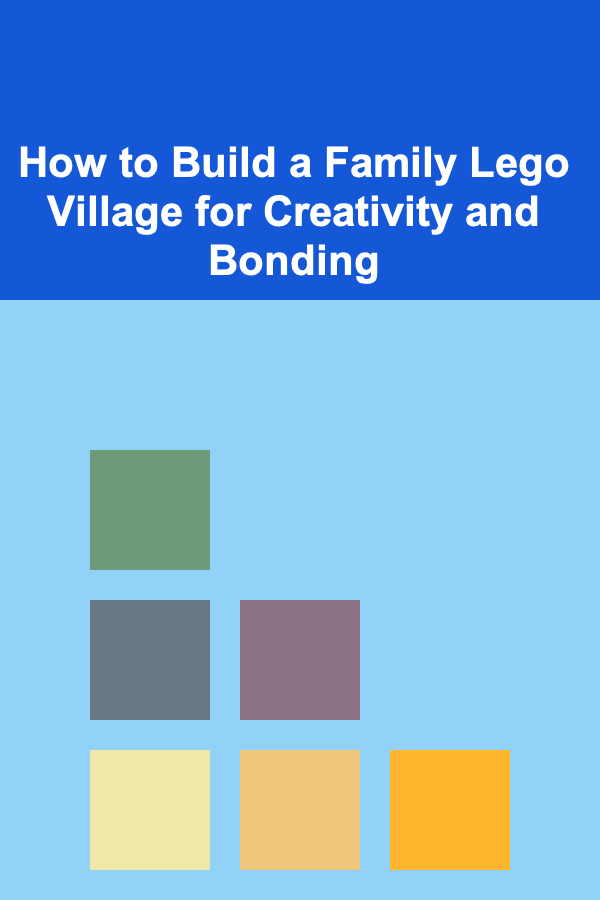
How to Build a Family Lego Village for Creativity and Bonding
ebook include PDF & Audio bundle (Micro Guide)
$12.99$8.99
Limited Time Offer! Order within the next:

Building a family Lego village is an enjoyable and rewarding activity that blends creativity, teamwork, and fun. Whether you're a parent, a sibling, or a grandparent, constructing a Lego village with family members allows everyone to express their imaginations, collaborate on projects, and create something beautiful together. It's a fantastic way to strengthen family bonds while also providing a creative outlet for all ages.
This article will explore how to build a Lego village that is both a fun family activity and a valuable learning experience. We'll break down the entire process---from brainstorming the design, choosing the right Lego sets, and building techniques, to incorporating storytelling and themes. Along the way, we will explore how creating a Lego village encourages problem-solving, enhances fine motor skills, and strengthens relationships within the family.
Why Build a Lego Village?
1. Fostering Creativity
Lego bricks are a timeless tool for sparking imagination. When building a Lego village, family members are encouraged to create their own mini-world, each contributing their unique ideas and perspectives. Whether you want to build a bustling city, a serene countryside, or a futuristic town, the sky's the limit when it comes to the stories and structures that can be created.
The process of planning, designing, and constructing a Lego village pushes everyone to think outside the box. Parents and children alike are encouraged to explore new building techniques, use colors and shapes creatively, and bring their ideas to life with bricks.
2. Enhancing Problem-Solving Skills
Lego construction is much more than simply stacking bricks. Building a Lego village requires critical thinking, strategy, and planning. Family members must decide on the overall layout, allocate resources (i.e., bricks and accessories), and ensure that the structures are stable and well-designed.
For children, building a Lego village encourages them to think logically about how different pieces fit together. Parents can guide their children through these thought processes, helping them understand concepts like symmetry, balance, and spatial relationships. It's an excellent way to develop problem-solving skills that are essential in everyday life.
3. Promoting Family Bonding
One of the most significant benefits of building a Lego village is the opportunity it provides for family bonding. Working together on a shared project fosters communication, cooperation, and teamwork. Family members collaborate on ideas, make joint decisions, and support each other as they build the village piece by piece.
Whether parents work with their kids or siblings collaborate, building a Lego village encourages interaction and creates positive memories. It's a perfect opportunity to engage in meaningful conversations while constructing something that everyone can enjoy.
4. Learning Patience and Perseverance
Building a Lego village is not a fast process. It can take hours or even days to complete, depending on the complexity of the design. During the process, family members will learn the importance of patience and perseverance. Mistakes are inevitable, but they can also be opportunities for growth and learning. If something doesn't fit or a piece is missing, the family will need to problem-solve, try different approaches, and persist in the face of challenges.
The slow and deliberate pace of building the village encourages mindfulness, teaching both kids and adults how to stay focused and determined until the project is finished.
Steps to Build Your Family Lego Village
1. Gather Materials and Supplies
Before you begin building, it's essential to gather all the necessary materials and tools. This includes not just Lego bricks, but also any accessories or decorations that can add flair to your village. Some families may have a large stock of Lego bricks, while others might need to purchase specific sets to get started.
Essential Supplies:
- Lego Bricks: Aim for a variety of bricks, including baseplates, walls, windows, roofs, and decorative items. Lego sets with themes like city, medieval, or town might be helpful, but you can also mix and match pieces from other collections.
- Baseplates: These are crucial for creating the foundation of your Lego village. Choose a few large baseplates to provide a stable surface for your village, or combine smaller plates for a custom arrangement.
- Lego Accessories: Consider Lego people, animals, trees, cars, and other decorative elements to make the village come alive.
- Storage Bins: Keeping your Lego pieces organized will save you time as you work. Storage bins or containers are useful for sorting bricks by size, color, or type.
- Tools: While Lego bricks usually fit together easily, a brick separator can be useful for removing pieces that are tightly stuck together.
2. Plan the Layout of Your Village
Before diving into construction, it's a good idea to sit down with your family and plan the layout of your village. This is where creativity comes into play---what kind of village do you want to create? Is it a bustling urban center, a peaceful rural town, or something more imaginative?
Design Ideas:
- City Layout: Your village could include skyscrapers, a town square, parks, roads, and vehicles. You can also create a diverse set of buildings, such as houses, shops, schools, and fire stations.
- Countryside or Farm Setting: Build a small farming community with barns, fields, windmills, and livestock. Incorporate natural elements like lakes, hills, and forests.
- Fantasy Village: If you're in the mood for something more fantastical, design a village inspired by medieval castles, magical creatures, or space exploration. The possibilities are endless!
- Themed Village: Consider creating a theme, such as a holiday village (Christmas, Halloween), a historical setting (Victorian, Ancient Rome), or even a Lego version of a favorite movie or book series.
Once you decide on a theme, sketch out the basic layout on paper or use an online Lego design tool to visualize how the village will look. Take into account the size of the baseplates and how different sections of the village will fit together. Will there be roads or pathways? Where will buildings be placed, and how will they be arranged?
3. Build the Structures
Now comes the fun part: the building! Start by constructing the most important elements of your village, such as the central buildings or landmarks. If you're working with young children, consider having them build smaller, simpler structures while more complex designs can be tackled by older family members.
Tips for Building:
- Start with the Basics: Begin by creating the foundation of each building. Lay down a solid base and ensure it is secure before moving on to the walls and roof. If necessary, use reinforced bricks for extra support.
- Use Layers: To create texture and depth, build your structures in layers. Each layer can represent a floor or section of the building, and you can use different types of bricks to create variety in the walls and roofs.
- Detailing: Add windows, doors, and other small accessories to give the buildings a finished look. Use Lego people to populate your village, and add trees, fences, and vehicles to make it more dynamic.
- Collaborate: Share tasks with other family members, working on different sections of the village. This will make the process go faster and give everyone the opportunity to contribute their ideas.
4. Incorporate Storytelling
As you build, it's important to think about the stories behind the buildings and people in your village. What do the residents do? What is their daily life like? Building a Lego village is a fantastic way to engage in storytelling with your family. Create characters and narratives that connect the buildings, like a baker who owns the bakery, a teacher who works at the school, or a firefighter stationed at the firehouse.
This is an excellent opportunity for parents to introduce storytelling techniques to younger children. Ask them about the characters' motivations, challenges, and goals. What are the relationships between the people in the village? This kind of role-playing encourages empathy, creativity, and imagination.
5. Add the Final Touches
Once the structures are in place, it's time to add the final touches to your Lego village. This includes landscaping, decorations, and small details that bring the village to life.
- Landscaping: Add trees, plants, and flowers around the village. If you're creating a rural setting, consider adding animals such as cows, chickens, or horses. For a city, place benches, streetlights, and vehicles along the roads.
- Lighting: If you're feeling ambitious, add small Lego lighting kits to illuminate your village at night. This will give your village a magical, life-like quality.
- Interactive Elements: Consider adding features that allow family members to interact with the village, such as movable cars, doors that open, or working wheels on vehicles or buildings.
6. Display Your Lego Village
Once your Lego village is complete, proudly display it for everyone to see. Whether it's placed on a shelf, a table, or a dedicated display area, your Lego village will be a beautiful representation of your family's creativity and teamwork. It's also a great conversation piece that can spark new ideas for future builds.
Consider photographing your village or even creating a time-lapse video to document the entire building process. This can be a fun way to preserve the memories of the project and show how it evolved over time.
7. Keep Building and Expanding
A Lego village is never really "finished." As new Lego sets are released or as your family's interests change, you can add new structures, characters, and themes to the village. Over time, your Lego village will become a dynamic, evolving world that reflects your family's journey and creative growth.
Conclusion
Building a Lego village with your family is more than just an enjoyable pastime; it's an enriching experience that fosters creativity, communication, and collaboration. It offers a unique opportunity for family members of all ages to work together, solve problems, and create something meaningful. By designing and constructing your village, you not only make lasting memories but also strengthen bonds that will endure for years to come.
So, gather your bricks, pick a theme, and get started on a family project that will inspire imagination, laughter, and teamwork. Your Lego village will be more than just a collection of buildings; it will be a reflection of your family's creativity, love, and shared experiences.

How to Create a Dedicated Space for Group Fitness Classes
Read More
How to Delegate Errands Effectively When You're Busy
Read More
How to Make the Most of Utilizing Community Resources for Families
Read More
How to Market Your Web Consultant Side Hustle to Global Clients
Read More
How to Stage Your Home for Maximum Storage Appeal
Read More
How to Use Fabric and Textiles to Add Holiday Spirit to Your Home
Read MoreOther Products

How to Create a Dedicated Space for Group Fitness Classes
Read More
How to Delegate Errands Effectively When You're Busy
Read More
How to Make the Most of Utilizing Community Resources for Families
Read More
How to Market Your Web Consultant Side Hustle to Global Clients
Read More
How to Stage Your Home for Maximum Storage Appeal
Read More